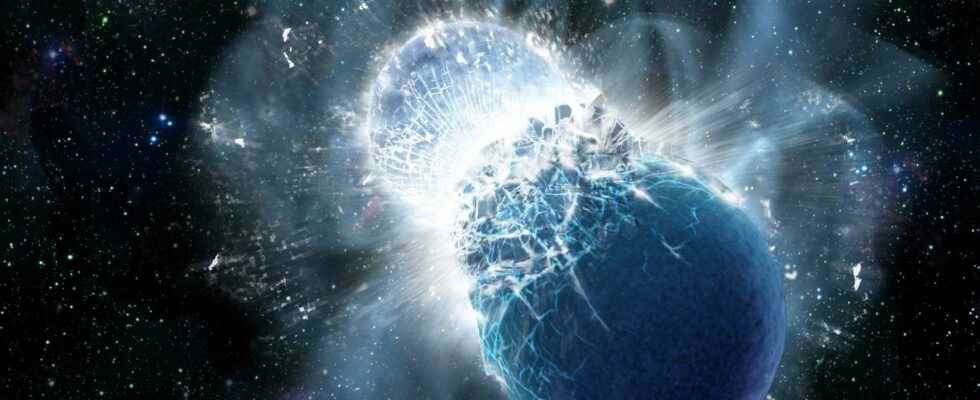You will also be interested
[EN VIDÉO] Gamma-ray bursts: neutron star collisions light up the Universe Gamma-ray bursts are the brightest events in the Universe in the field of electromagnetic waves. We can observe one per day on average on the celestial vault and they occur in distant galaxies. There are two types, short and long. This video explains the nature of short bursts.
Many advances in astronomy have resulted from the opening of a new window observation in a new band of the spectrum electromagnetic. The X-rays revealed the stellar black holesthe Rays infrared inside star nurseries and decimeter radio waves the arm structure of the Milky Way.
This is one of the reasons for the design of theAtacama Large Millimeter/submillimeter Array (Alma). Another, complementary, is that the network of radio telescopes constructed in this way makes it possible to opening summary and therefore to have a very large virtual instrument without having to create it.
Today, we learn that the Alma radio telescope network was used for a major first, to observe in the field radio millimeter and sub-millimeter processes astrophysics associated with kilonovae. Remember that these are collisions ofneutron stars which was first discovered in the form of jerks short gamma rays, the nature of which has only recently been determined, although it has been suspected for decades. The energy released is colossal, which makes gamma-ray bursts among the most luminous phenomena of the cosmos.
In this artist’s video, two neutron stars of low dimension but very high density are about to merge and explode into a kilonova. This particularly rare event results in the emission of gravitational waves and short gamma-ray bursts. The two emissions were actually observed on August 17, 2017, respectively by Ligo-Virgo and Fermi/Integral. Various detailed observations carried out using ESO telescopes have confirmed the nature of this object – a kilonova – located within the galaxy NGC 4993 some 130 million light-years from Earth. This type of object is the main source of heavy chemical elements, such as gold and platinum, in the Universe. © ESO
Key to this determination has been the rise of multi-messenger astronomy with simultaneous detection by Ligo and Virgo ofgravitational waves coming from the source GW170817, clearly associated on the celestial vault with emissions ofelectromagnetic waves both in the X and gamma domain (GRB 170817A) – observed by satellites Chandra and Closed -, than in the visible domain with the Las Cumbres Observatory to cite only these instruments.
Neutron star collisions that produce gold and platinum
This time, the astrophysicists published an article in The Astrophysical Journal Lettersa version of which is freely available on arXivwhich talks about the observed GRB 211106A short gamma-ray burst – like its name of Gamma Ray Burst indicates, on November 6, 2021. As in the case of the source of gravitational waves (Gravitational Wave) observed on August 17, 2017, the collision between neutron stars arises from the fact that the two stars compacts lost energy in the form of gravitational waves faster and faster, which led them to fall inexorably and faster and faster towards each other.
Fusion not only had to produce thermonuclear reactions at the origin of the birth of heavy elements like gold and platinumbut also a collimated particle beam at very high gears also producing an equally collimated beam of photons high energy gamma. The Earth passed through this beam by chance like an observer illuminated by a lighthouse.
The jet of particles and gamma photons by injecting itself into the interstellar medium excites it and forces the matter it contains, to shine in response. It is this radiation remanent which was detected for the first time in the spectral band accessible to Alma. Prior to this instrument, telescopes millimeters were not sensitive enough to detect these afterglows, as GRBs are often observed at billions oflight years of the Milky Way. We therefore observe only the old GRBs and we also suspect that for a still unknown reason, they were more abundant during the first billion years of the history of the cosmos. In fact, GRB 211106A occurred while theUniverse observable was only 40% of its current age. However, even if the kilonovae are clearly visible from afar in gamma, this is no longer the case with the remanent radiation which is much less luminous.
Initially, when only the X-ray counterpart of GRB 211106A was discovered using the satellite Swiftastrophysicists thought that the kilonovae could still come from a neighboring galaxy, although we could not associate one with it. via observations in the visible with Hubble – probably due to the presence on the line of sight near the GRB of a large quantity of dust.
But finally, thanks to Alma, it was possible to find a faint and distant galaxy where the gamma-ray burst occurred. The distance determined, it was necessary to conclude that it was one of the most powerful GRBs detected to date…
Alma, in conjunction with JWST observations (James Webb Space Telescope) should make it possible to go even further in the study of short gamma-ray bursts.
The GW170817 detection saga. To obtain a fairly accurate French translation, click on the white rectangle at the bottom right. The English subtitles should then appear. Then click on the nut to the right of the rectangle, then on “Subtitles” and finally on “Translate automatically”. Choose “French”. © Science vs Cinema
Interested in what you just read?
